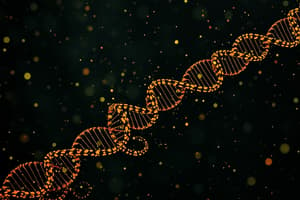Podcast
Questions and Answers
What are some examples of genes where adaptive selection is observed, according to the provided text?
What are some examples of genes where adaptive selection is observed, according to the provided text?
Genes involved in pathogen defense/recognition interaction, genes in pathogens to overcome our immune systems, and vertebrate lysozymes (diet).
What are some tools/resources mentioned in the text for studying selection and sequence variation?
What are some tools/resources mentioned in the text for studying selection and sequence variation?
https://www.hiv.lanl.gov/content/sequence/SNAP/SNAP.html, https://www.hiv.lanl.gov/content/sequence/CodonAlign/codonalign.html, http://www.datamonkey.org/, http://www.datamonkey.org/busted, https://www.hiv.lanl.gov/content/sequence/HIV/links.html, http://www.ub.edu/dnasp/, https://tanguay.info/learntracker/page/lectureNotesItems.idCode=molecularclock, http://www.lecb.ncifcrf.gov/~toms/sequencelogo.html, http://weblogo.berkeley.edu/, http://weblogo.threeplusone.com/create.cgi
What is the molecular-clock hypothesis and how is it related to DNA sequences?
What is the molecular-clock hypothesis and how is it related to DNA sequences?
The molecular-clock hypothesis states that DNA sequences in a genome change through spontaneous mutation at a constant rate. It can be used to estimate how long ago two species diverged from a common ancestor.
What is the purpose of a sequence logo and what does it display?
What is the purpose of a sequence logo and what does it display?
What is the alternative tool mentioned for finding conserved or visually displaying conserved regions in DNA or amino acid sequences?
What is the alternative tool mentioned for finding conserved or visually displaying conserved regions in DNA or amino acid sequences?
What type of alignment is needed for creating sequence logos?
What type of alignment is needed for creating sequence logos?
What can the sequence logos be used to display?
What can the sequence logos be used to display?
What is the purpose of the mentioned DNA polymorphisms tool (http://www.ub.edu/dnasp/)?
What is the purpose of the mentioned DNA polymorphisms tool (http://www.ub.edu/dnasp/)?
What is the Newick notation for the tree with leaf nodes A, B, C, and D?
What is the Newick notation for the tree with leaf nodes A, B, C, and D?
What is the New Hampshire tree format for the tree with leaf nodes 13Xerula, 4Gymnopus, 3Gymnopus, 11Marasmiu, 12Hemimyce, 9Hydropus, 10Megacoll, 5Clitocybu, 7Mycena, 8Mycena, Macrolepio, Melanophyl, Laccaria-l, 2Tephrocyb, 1Tephrocyb, 2Lyophyllu, 1Lyophyllu, Lepista-ir, Clitocybe-, Tricholoma, Hypsizygus, LH10, LH7, LH6, LH5, and LH2?
What is the New Hampshire tree format for the tree with leaf nodes 13Xerula, 4Gymnopus, 3Gymnopus, 11Marasmiu, 12Hemimyce, 9Hydropus, 10Megacoll, 5Clitocybu, 7Mycena, 8Mycena, Macrolepio, Melanophyl, Laccaria-l, 2Tephrocyb, 1Tephrocyb, 2Lyophyllu, 1Lyophyllu, Lepista-ir, Clitocybe-, Tricholoma, Hypsizygus, LH10, LH7, LH6, LH5, and LH2?
What does the output from bootstrap analysis Sepboot-->DNApars provide in the treefile?
What does the output from bootstrap analysis Sepboot-->DNApars provide in the treefile?
What type of analysis is used to generate the treefile output (bootstrap analysis: Sepboot-->DNApars)?
What type of analysis is used to generate the treefile output (bootstrap analysis: Sepboot-->DNApars)?
- What is the purpose of ancestral sequence reconstruction in phylogenetic analysis?
- What is the purpose of ancestral sequence reconstruction in phylogenetic analysis?
- How is the concept of selection (dN/dS) relevant in the context of alignment analysis?
- How is the concept of selection (dN/dS) relevant in the context of alignment analysis?
- What is the significance of SYNSCAN analysis in identifying gene selection and functional constraints?
- What is the significance of SYNSCAN analysis in identifying gene selection and functional constraints?
- How does the neutral theory of evolution impact rates of substitutions and codon bias?
- How does the neutral theory of evolution impact rates of substitutions and codon bias?
- What are the requirements outlined for using SYNSCAN or MEGAX for selection options?
- What are the requirements outlined for using SYNSCAN or MEGAX for selection options?
- How does the concept of outgroup relate to rooting trees in phylogenetic analysis?
- How does the concept of outgroup relate to rooting trees in phylogenetic analysis?
- What is the role of the FASTML Server in ancestral sequence reconstruction?
- What is the role of the FASTML Server in ancestral sequence reconstruction?
- How can sequence logos be utilized in the context of alignment analysis?
- How can sequence logos be utilized in the context of alignment analysis?
- What are the potential limitations of using dN and dS values for entire genes in determining functionality?
- What are the potential limitations of using dN and dS values for entire genes in determining functionality?
- What program is discussed for estimating gene selection in the text, and what are its applications?
- What program is discussed for estimating gene selection in the text, and what are its applications?
- What online tool is mentioned for tree display in the text, and what is its name?
- What online tool is mentioned for tree display in the text, and what is its name?
- How is the concept of rooting trees related to the use of the TreeView program?
- How is the concept of rooting trees related to the use of the TreeView program?
Flashcards are hidden until you start studying
Study Notes
Phylogenetic Tree Analysis and Ancestral Sequence Reconstruction
- The text contains a Newick notation representation of a phylogenetic tree involving various species of small mushrooms.
- Bootstrap support values are provided for leaf nodes in the phylogenetic tree.
- The text mentions an online tool for tree display called iTOL, and provides a link to it.
- It discusses the use of the TreeView program and rooting trees, as well as the concept of outgroup in phylogenetic analysis.
- Ancestral sequence reconstruction is described, and the FASTML Server for computing Maximum Likelihood ancestral sequence reconstruction is mentioned.
- The text explains the concept of selection (dN/dS) and sequence logos in the context of alignment analysis.
- SYNSCAN analysis, a program for estimating gene selection, is discussed, along with its application in identifying functional constraints and neutral evolution.
- The neutral theory of evolution and its implications on rates of substitutions and codon bias are explained.
- The text outlines the requirements for using SYNSCAN or MEGAX for selection options and emphasizes the importance of assembling alignments without indels.
- It provides an example showing how SYNSCAN can indicate functional constraints or non-functionality in a gene of interest based on the dN and dS values.
- The program's usefulness in identifying genes under purifying selection or gaining new functions is highlighted, along with the variability in dN and dS values.
- The text discusses the potential limitations of using dN and dS values for entire genes in determining functionality, as small changes in specific parts of a gene may lead to higher dN values.
Studying That Suits You
Use AI to generate personalized quizzes and flashcards to suit your learning preferences.




